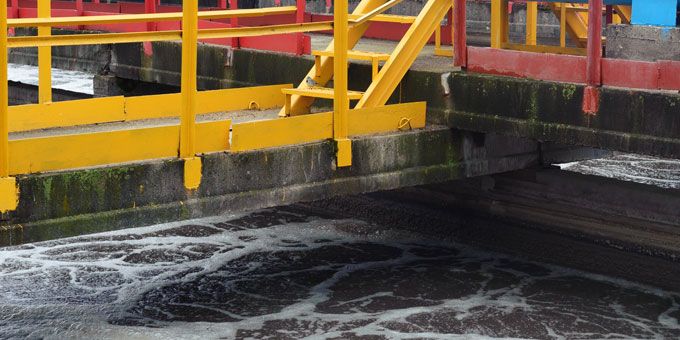Robots are getting more advanced, and as the technology improves, industries find more ways to use it. The water industry is no exception. Here are five ways robotics innovations are helping it.
 5 Ways Robotics Are Benefiting the Water Industry
5 Ways Robotics Are Benefiting the Water Industry

Kayla Matthews | Productivity Bytes
Robots are getting more advanced, and as the technology improves, industries find more ways to use it. The water industry is no exception. Here are five ways robotics innovations are helping it.
1. To Improve Leak-Detection Methods
Researchers know leaks are substantial contributors to the global water scarcity problem. In Saudi Arabia, for example, up to 30% of the water gets lost due to leaks and maintenance problems. And, some people live in areas where water scarcity forces cities to restrict access for hours each day or get water sent in from elsewhere.
A company called WatchTower Robotics built a prototype of a soft-sided robot that can move along the inside of a pipe. Its sensors detect changes in force caused by water escaping due to a leak. It can also confirm the location of a leak within a couple of feet. That's far superior to current methods that often require water utility workers to dig up substantial sections of streets to find the source of a problem.
2. To Clean Drinking-Water Tanks
Keeping the tanks that store drinking water clean is a time-consuming task. The two primary techniques for doing it now involve draining the tanks or getting divers to handle the job. But, a few robotics companies are trying to meet the need differently. One is an Australian entity called Fremantle Commercial Diving. It has provided diving services for potable water tanks for three decades.
After the company realized the need and current marketplace gap for robots to clean the water tanks, it created a division called Watertight Robotics. The firm began by studying the robots used elsewhere and modifying them for the Australian market. All the robots in its fleet are oil-free or use tiny amounts of food-grade oil. Also, when the robots take care of the cleaning, they do not stir up the water or otherwise harm the supply.
3. To Enhance Operations at Water Treatment Facilities
Facilities ranging from nuclear power plants to hospitals often use closed-loop systems to meet their water treatment needs. This approach brings advantages including increased efficiency and reduced opportunities for contaminant exposure. Some companies are investigating bringing robots in to help with water treatment, too.
A partnership aims to evaluate the effects of using robots to assist with wastewater treatment needs in Aarhus, a city in Denmark growing at a rate of 5,000 people per year. More specifically, the project will examine whether it's feasible to depend on robots to maintain the outdoor areas of wastewater treatment plants or help with some tasks that require heavy lifting. Drones may also handle some plant inspections.
4. To Look for Water Pollution
Professionals in the water industry play instrumental roles in ensuring water is safe to drink. Part of that necessity means disposing of wastewater responsibly. However, representatives from other sectors need to take the same initiative. In Texas, a report found chicken plants in the area were sending wastewater with high levels of nitrogen and phosphorus into nearby waters and lakes.
Robots could make it easier to tell when those issues happen, giving the authorities more leverage to penalize the parties as appropriate. An eel-inspired robot has both artificial and biological sensors that screen for specific pollutants in the water and gauge the toxicity levels without disrupting the animals and plants living in the body of water.
The researchers involved with it say the machine performed well in lab tests. The robot also offers the option to customize the sensors to look for particular kinds of contaminants.
5. To Reduce Unnecessary Pipe Replacement Projects
Currently, most parties in the industry use a vastly inefficient system of replacing water pipes. They typically only replace the pipes according to their age, and do about a half-percent of the entire network annually. That means it would take centuries to replace the whole network. Also, replacing the pipes is extraordinarily expensive. In a city like San Francisco, one mile of replacement pipe costs about $3 million.
A company called HiBot USA may have a solution. It uses algorithms and robots to figure out which pipes in a city or town are most likely to need replacement. The water industry uses a letter grading system based on a pipe's age and history of leaks. An A-graded pipe is in the best condition, while an F-graded pipe is likely to fail soon.
Hi-Bot USA sends robots into the pipes to assess their condition and the appropriateness of the assigned grade. The company believes its system can predict future failure rates with an 80 to 90% accuracy rate. Then, companies could better allocate their resources and target the pipes that are most likely to cause problems soon.
Compelling Reasons to Use Robotics in the Water Sector
This list gives an overview of some of the pioneering ways to apply robotics to the water industry. These use cases and others like them could help water providers operate more efficiently and give customers more consistent access to clean, safe water.
The content & opinions in this article are the author’s and do not necessarily represent the views of RoboticsTomorrow
Featured Product

